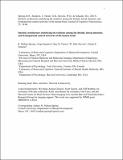| dc.contributor.author | Spreng, R. Nathan | |
| dc.contributor.author | Sepulcre, Jorge | |
| dc.contributor.author | Turner, Gary R. | |
| dc.contributor.author | Stevens, W. Dale | |
| dc.contributor.author | Schacter, Daniel L. | |
| dc.date.accessioned | 2014-02-28T15:33:31Z | |
| dc.date.issued | 2013 | |
| dc.identifier.citation | Spreng, R. Nathan, Jorge Sepulcre, Gary R. Turner, W. Dale Stevens, and Daniel L. Schacter. 2013. Intrinsic Architecture Underlying the Relations among the Default, Dorsal Attention, and Frontoparietal Control Networks of the Human Brain. Journal of Cognitive Neuroscience 25(1): 74-86. | en_US |
| dc.identifier.issn | 0898-929X | en_US |
| dc.identifier.uri | http://nrs.harvard.edu/urn-3:HUL.InstRepos:11829167 | |
| dc.description.abstract | Human cognition is increasingly characterized as an emergent property of interactions among distributed, functionally specialized brain networks. We recently demonstrated that the antagonistic “default” and “dorsal attention” networks—subserving internally and externally directed cognition, respectively—are modulated by a third “frontoparietal control” network that flexibly couples with either network depending on task domain. However, little is known about the intrinsic functional architecture underlying this relationship. We used graph theory to analyze network properties of intrinsic functional connectivity within and between these three large-scale networks. Task-based activation from three independent studies were used to identify reliable brain regions (“nodes”) of each network. We then examined pairwise connections (“edges”) between nodes, as defined by resting-state functional connectivity MRI. Importantly, we used a novel bootstrap resampling procedure to determine the reliability of graph edges. Furthermore, we examined both full and partial correlations. As predicted, there was a higher degree of integration within each network than between networks. Critically, whereas the default and dorsal attention networks shared little positive connectivity with one another, the frontoparietal control network showed a high degree of between-network interconnectivity with each of these networks. Furthermore, we identified nodes within the frontoparietal control network of three different types—default-aligned, dorsal attention-aligned, and dual-aligned—that we propose play dissociable roles in mediating internetwork communication. The results provide evidence consistent with the idea that the frontoparietal control network plays a pivotal gate-keeping role in goal-directed cognition, mediating the dynamic balance between default and dorsal attention networks. | en_US |
| dc.description.sponsorship | Psychology | en_US |
| dc.language.iso | en_US | en_US |
| dc.publisher | MIT Press | en_US |
| dc.relation.isversionof | doi:10.1162/jocn_a_00281 | en_US |
| dash.license | OAP | |
| dc.title | Intrinsic Architecture Underlying the Relations among the Default, Dorsal Attention, and Frontoparietal Control Networks of the Human Brain | en_US |
| dc.type | Journal Article | en_US |
| dc.description.version | Accepted Manuscript | en_US |
| dc.relation.journal | Journal of Cognitive Neuroscience | en_US |
| dash.depositing.author | Schacter, Daniel L. | |
| dc.date.available | 2014-02-28T15:33:31Z | |
| dc.identifier.doi | 10.1162/jocn_a_00281 | * |
| dash.contributor.affiliated | Schacter, Daniel | |
| dc.identifier.orcid | 0000-0002-2460-6061 | |


